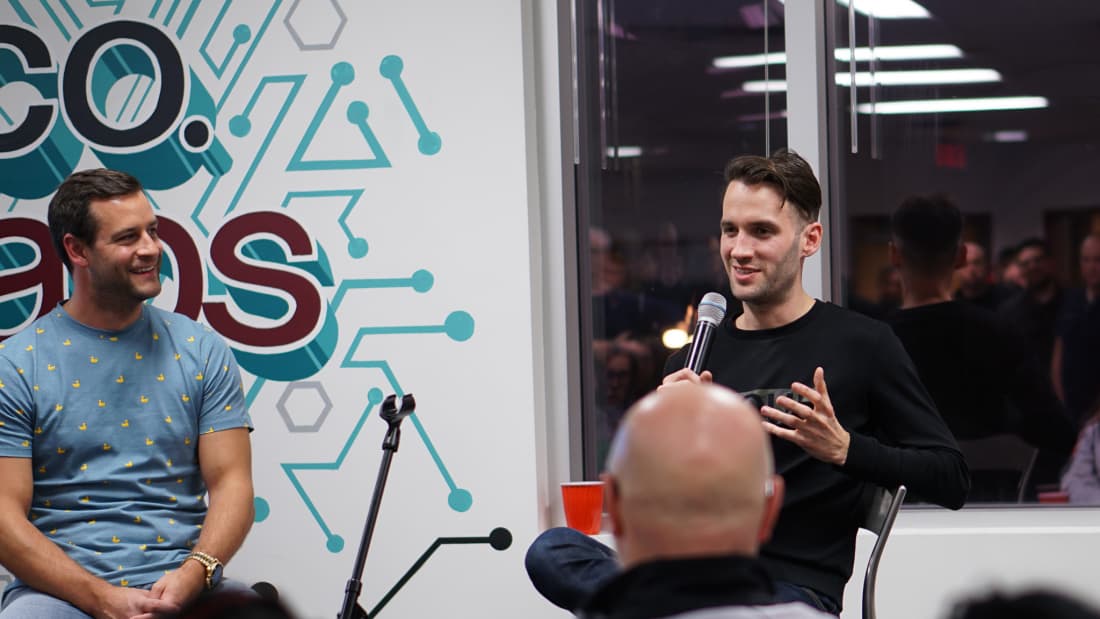Known for its rich oil and vast farmland, Saskatchewan hides away a potential for a thriving technological industry. Saskatoon, the province’s biggest city, is quietly, but surely, beginning to transform itself into a tech hub.
In 2019 alone, Saskatchewan received nearly $100 million in venture capital investment, more than half of which went to Saskatoon-based tech companies. The tech sector is estimated to account for 2.5 per cent of all Saskatchewan businesses, adding about $2 billion in GDP to the provincial economy in 2017.

This rapid growth is the result of demonstrated efforts, from the provincial government to the young, vibrant community of ambitious self-starters. The Saskatchewan tech scene went through huge changes in the past five years and there are still more to come. The increased interest and investment in the provincial tech ecosystem promise continued growth.
“There seems to be in Saskatchewan this really beautiful opportunity where we have alignment across the board. Everyone is agreeing this is the right thing,” said Alex Shimla, program director at Co.Labs.
Co.Labs is Saskatchewan’s first tech incubator and it provides all the tools necessary to grow and scale a tech startup in the province. They are purpose-driven to create a pipeline to funnel a technology from an idea to a million-dollar business in under three years.
One of the last provinces to have a startup incubator, Saskatchewan is seeing a lot of potential coming out of Co.Labs, which is less than three years old. Co.Labs programs have benefited 85 companies, who have collectively raised more than $6.2 million in equity investments and created more than 150 jobs.
The existence of a centralized tech hub like Co.Labs signals increased support for tech entrepreneurship in the province. The future of the sector seems bright, but it has had its share of struggles. Five years ago, the Saskatchewan tech ecosystem was mostly driven by individual excellence.
“They were all just incredible entrepreneurs who grinded incredibly hard and did it independently and had to go outside of Saskatoon to make all those things happen,” Shimla said. “If you asked any of them, there’s a lot of mistakes that they made along the way that they feel [were] super easily avoidable.”
Back in 2015, Saskatchewan-based startups were struggling to access venture capital, raising only $3 million by the end of the year. Innovation Saskatchewan, a government agency with a focus on technology development and commercialization, recognized the difficulties for tech firms to secure their first big customer within the province.
Since then, Shimla says, “the support systems for tech have increased dramatically around the momentum that’s been built at Co.Labs and in the general ecosystem.”
On the policy level, the provincial government has created initiatives to support tech startups with the goal to triple the tech sector by 2030. These efforts help companies get a financial headstart into their market.
The Made in Saskatchewan Technology Program is designed to help Saskatchewan-based tech companies secure their footing through a $10,000 procurement contract with the government. Having a reference-worthy customer like the government is critical for new startups to establish themselves in the market and attract investors.
The Saskatchewan Technology Startup Incentive was officially introduced in 2018-19 to attract investors to the province. This program offers investors a 45 per cent non-refundable tax credit when they put capital towards early-stage tech startups. The incentive helps ease the financial struggles for new companies by making investments in Saskatchewan companies much more appealing.
We’re different from Vancouver. That’s a good thing. Vancouver is good at what it does, and that’s great. But Saskatoon can be and should be fundamentally unique because we are,”
Shimla said.
While benefiting from the government’s province-wide efforts, Saskatoon also enjoys a growing sense of community and support on the tech scene. Co.Labs, with funds from the government and interest from the community, is creating visibility on what is happening in the industry through regular community events.
“If a company is trying to raise money, there’s likely going to be an investor in the room at those events, there’s going to be students who are interested in the jobs … and there’s gonna be people from government who are interested in creating policy initiatives,” Shimla said.
Regular community events also happen all over Saskatoon, hosted by every single tech company, with a high turnout. This means that the entryway into the tech industry becomes easier for students and recent graduates.
Tate Cao, a University of Saskatchewan assistant professor and the La Borde Chair in Engineering Entrepreneurship, points out that the easiest way for students to get a foot in the tech space is to participate in these events and create a network of mentors.
“Be very observant looking for those opportunities. And then be open and humble to ask for help,” Cao said. “There is lots of help around [because] people love students and want to help students.”
While there is an emphasis on nurturing and helping students in the tech space, Shimla says one of the big obstacles to the growth of the Saskatchewan tech industry is the gap between the talent available and the number of job opportunities in the market.
The big question is, “can our talent pipelines keep up with the growth of our companies?”
Cao comments that the reason the number of graduates does not necessarily fulfill the needs for talent in the rapidly growing industry is the disconnect between the level of experiences needed and student’s lack thereof.
“What I see is sometimes there is a gap between the graduates and then the position companies want to hire for. Because oftentimes as companies grow, they need more experienced people, where students as new graduates lack those experiences,” Cao said.
This leads to companies seeking talents outside of the country, resulting in a natural diversification of their workforce.
“Diversity increases top line and bottom line performance of companies. When you have more diversity, you have more success because you have more opinions in the room that aren’t just saying the same thing,” Shimla said.
With these benefits, it is not about diversity to fill a quota — or a “measuring stick,” as Shimla puts it. Having more people with a wider variety of experiences and backgrounds gives those prospective employees, and their employers, a competitive advantage.

Still, local companies are always looking inward to foster and invest in local talent. To support the economic development of the province, the University of Saskatchewan is focusing on boosting enrolment in computer science and engineering.
“Enrolment in the computer science department has increased more than 70 per cent in recent years, but the demand for graduates continues to outpace our graduation numbers in this field,” reads the university’s 2020-21 Operations Forecast.
“The College of Arts and Science is adopting a suite of strategies designed to further boost enrolment through industry-aligned computer science program offerings.”
On the part of the College of Engineering, besides goals to maximize employment outcomes through internships and career services, they are also trying to bridge the gaps between skills and experience.
In addition to course offerings on product development, in collaboration with Edwards School of Business, the College of Engineering has created the technology innovation certificate. The certificate program gives students the business fundamentals to design and commercialize technologically-innovative solutions.
“My long-term plan for the next couple years is to establish more work with student groups and to create more opportunities for extracurricular works. So [to] expose students to real life situations and then learn from those opportunities,” Cao said. “We want to set up more workshops and events for students to learn the necessary skills.”
Students themselves recognize the importance of getting the experiences beyond the classroom. In February 2020, the engineering student body voted to implement the University of Saskatchewan Engineering Students’ Fund.
The approval of the fund comes with a mandatory $20 per term fee from each engineering undergraduate student and an annual donation of $20,000 from the College of Engineering. The engineering design teams and student groups will benefit from this fund through easier access to funding for their activities.
Shimla notes the efforts from the colleges in bringing technology into the curriculum as the university recognizes the importance of preparing students for the future of technology-integrated careers.
“We are working with the university at the head of entrepreneurship levels at most colleges … to start building a plan for how we teach these — not just entrepreneurship skills, but these tech-based methodologies because tech is just gonna keep growing,” Shimla said.
It is an exciting time for the Saskatoon tech scene as the pieces are coming together to build a structure that is fostering and setting up our local companies on the path to huge success. From the provincial government to the university to the community, we are seeing a positive and focused messaging around the importance of technology in the future of the province.
The global success of Solido Design Automation, for example, looked like a one-off phenomenon for years. In 2005, they set out to solve incredibly complicated problems in the semiconductor niche and became hugely successful with global clients like Apple before being acquired by multinational corporation Mentor Graphics.
As Saskatoon now has the space to share and rapidly transfer knowledge in the entrepreneurial scene, the methodology that Solido used for their fast growth has become repeatable. This is thanks to pioneers like Jeff Dyck, former vice-president of engineering at Solido and director of engineering at Mentor Graphics, who now sits on the board of Co.Labs. He is instrumental in guiding the development of the incubator as Saskatchewan’s tech focal point.

The city is growing as a tech hub. Even Saskatoon Mayor Charlie Clark called it a “Silicon Prairie,” referencing the global center for innovative technology companies in San Francisco. But to Shimla, Saskatoon should not aspire to mimic — we have our own special thing going on here.
“We’re different from Vancouver. That’s a good thing. Vancouver is good at what it does, and that’s great. But Saskatoon can be and should be fundamentally unique because we are,” Shimla said.
Our competitive advantage, Shimla says, comes from the people — humble to a fault, hardworking and obsessed with generating revenue by providing legitimate value.
Focusing on adding values by offering solutions to real problems is a good recipe for success. Cao says a common misstep when people set out to make a business is to do the expensive thing first, which is to develop the technology without asking where the market is and whether people really need it.
“The amazing part about tech is that it’s so broad. It’s ubiquitous market conditions because you can sell to anyone, anywhere,” Shimla said, so long as you are solving a legitimate problem.
So while fluctuating market conditions will affect the growth of the tech sector, in some sense, tech entrepreneurship is a safer career path than traditional jobs.
“If you look at the traditional sectors, now they’re suffering from all kinds of changes and losses of jobs,” Cao said.
Shimla contends, however, that “what tech is doing isn’t actually coming in and supplanting those industries.” They are adding value and helping diversify and innovate the economy.
“Every company is going to become a tech company sometime in the next couple of decades,” Shimla said. “Too often we think about these things as opposites, when really they’re all parts of the same story.”
The next five years are going to be the period of critical growth for the Saskatoon tech ecosystem. There will be challenges in terms of seeking and retaining talent, as well as securing reliably increasing capital investments. But the opportunities are abundant for students to make a meaningful difference.
—
Minh Au | Web Editor
Photos: Supplied | Co.Labs